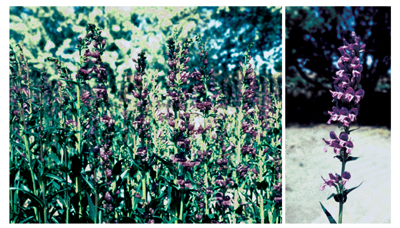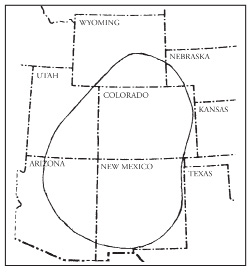Bandera' Rocky Mountain Penstemon
CR 472
Revised by Curtis W. Smith
College of Agricultural, Consumer and Environmental Sciences, New Mexico State University
Author: Extension Horticulture Specialist, Department of Extension Plant Sciences, New Mexico State University. (Print Friendly PDF)
'Bandera' Rocky Mountain Penstemon
'Bandera' Rocky Mountain penstemon (Penstemon strictus Benth.) is an herbaceous, perennial plant that is useful for beautification, soil stabilization, and ornamental landscaping. It also helps diversify wildlife diets.
Its beautiful flowers and evergreen basal rosette make this plant attractive for ornamental planting. Penstemons, in general, make excellent ground cover and soil stabilization plants because of their fibrous root system and their spreading, layering type of growth.
'Bandera' was released by the Agricultural Experiment Stations at New Mexico State University and Colorado State University, New Mexico State Highway Department, and Natural Resource Conservation Service of the USDA.

Figure 1. Rocky Mountain penstemon in flower.
Origin and Description
'Bandera' seeds were first collected in the ponderosa pine zone northwest of Mountainair, New Mexico. The approximate elevation and average annual precipitation at the location are 7,400 feet (2,257 m) and 16 to 18 inches (41 to 46 cm) per year, respectively. In addition to ponderosa pine, probable associated species are Arizona fescue, mountain muhly, blue grama, and western wheatgrass. The variety was initially tested at the USDA-Natural Resources Conservation Service (NRCS) Plant Materials Center as NM-628.
'Bandera' has an abundance of shiny, dark green leaves. The lower leaves form a basal rosette. Some of the basal leaves turn reddish-purple in winter, while the remainder stay green throughout the year. Under cultivation, the basal leaves may be as long as 6 inches (15 cm) and as wide as 1 inch (2.5 cm). The upper leaves may be as long as 4 inches (10 cm) and as wide as 3/4 inch (2 cm).
The basal diameters of mature, individual plants average 20 inches (51 cm), but they may be as large as 30 inches (76 cm) with optimum amounts of water and soil nutrients.
The stout stems are spreading to upright and grow from 8 to 23 inches (20 to 71 cm) in height. The flowering stalk is elongated and erect. Removal of this stalk after flowering will ensure flowers the following year. Abundant and showy flowers range from blue to violet (Figure 1). The tube and throat of the flowers are often lighter in color. Flowering occurs primarily between mid-May and mid-June. (Flowering does not generally occur during the first year of growth.) Seed matures in late July or early August.
The roots, primarily fibrous, grow in the top 6 inches (15 cm) of the soil.
Suitability
The natural range of Rocky Mountain penstemon is central and northern New Mexico, Colorado, southern Wyoming, Utah, and northeastern Arizona (Figure 2). It is found on rocky to sandy loam soils at elevations of 6,000 to 11,000 feet (1,830 to 3,355 m). Under cultivation, as in gardens or lawns, it can be grown at lower elevations.

Figure 2. Area of adaptation of 'Bandera' Rocky Mountain penstemon.
Establishment and Propagation
'Bandera' is easily established from seed, and seedling vigor is generally good. Plant the seed at a depth of 1/4 to 1/2 inch (6 to 12 mm) during the fall or early winter. The soil must be kept moist after planting for natural stratification (moist, cold treatment) to occur. 'Bandera' can also be established from sprigs obtained by dividing the base of older plants. Sprigs need some roots and a few leaves for best results. Basal portions of the stems also layer, or root, readily in moist soil.
Few disease or insect problems have been noted. However, Fusarium wilt has been observed on 'Bandera' growing on irrigated sandy loam, though not on clay or clay loam soil. Occasionally, scale insects attack plants that have low vigor.
Availability
For information on seed sources or on the management and use of 'Bandera' Rocky Mountain penstemon, contact your local county Extension office or the USDA-NRCS.
Original authors: Helen Wolfe, research assistant, Plant Materials Center; Joseph C. Fraser, research specialist, Plant Materials Center; W. R. Oaks, manager, Plant Materials Center; R. F. Hooks, associate professor of horticulture and superintendent, Middle Rio Grande Branch Station, New Mexico State University; and James Sais, urban horticulturist, Cooperative Extension Service, New Mexico State University.
Partial funding for original preparation of this publication was provided by the New Mexico Crop Improvement Association, Environmental Protection Agency, and USDI-Office of Surface Mining in cooperation with USDA Soil Conservation Service's Los Lunas Plant Materials Center.
To find more resources for your business, home, or family, visit the College of Agricultural, Consumer and Environmental Sciences on the World Wide Web at pubs.nmsu.edu
Contents of publications may be freely reproduced for educational purposes. All other rights reserved. For permission to use publications for other purposes, contact pubs@nmsu.edu or the authors listed on the publication.
New Mexico State University is an equal opportunity/affirmative action employer and educator. NMSU and the U.S. Department of Agriculture cooperating.
Revised and electronically distributed November 2009, Las Cruces, NM


